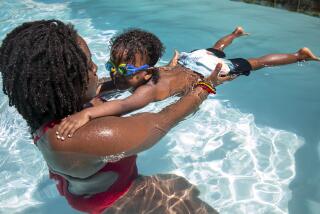Child Drownings Can Be Minimized
- Share via
Thank you for raising awareness about the devastating realities associated with childhood drowning in your June 28 article “Minutes that Cost an Eternity.”
The personal stories proved that this kind of tragedy can and does happen to good, responsible families. Yet accidental drowning continues to be a leading cause of death and injury to children under 5.
The statistics are alarming. A child under the age of 4 is 14 times more likely to die in a pool than a car crash. More than half of the approximately 1,150 children who drown each year are under the age of 4. Of the 5,000 children who are hospitalized each year due to drowning, 5% to 20% suffer severe and permanent disability. The cost of sustaining the life of a near-drowning victim is staggering--up to $200,000 a year.
We are at the height of the “drowning season.” Two-thirds of all drownings happen between May and August, with 40% occurring on Saturday or Sunday. Where do these accidents occur? Fifty percent are in residential swimming pools, either at home or at a friend’s, relative’s or neighbor’s pool. But drowning can also happen in bathtubs and spas or even in something as unlikely as a bucket or a toilet.
The key preventive factor is vigilance, assigning water watchers and assuring that layers of protection are in place. A five-foot fence that cannot be climbed and completely surrounds the pool or spa, alarms on doors and windows leading to the water, self-closing and self-latching gates, and pool safety covers are the action steps homeowners should take.
CAPT. SCOTT BROWN
Orange County Fire Authority
*
What a tragedy for 3-year-old Garrett Brann, Vincent Pastorelle and all the other profoundly and irreversibly brain-damaged toddlers of near-drownings.
What a different life these little tykes would have today if their parents had taught them two basic and very simple swimming skills. Namely, back floating and to jump into the water and paddle back to the side of a pool (children don’t fall into the middle).
People are brain-washed [about] teaching infants to “swim,” read paddle. It gives parents a false sense of security. [Nor does] a closed and locked fence give the protection that is needed.
Most drownings occur in a pool with a locked fence. I’m not suggesting that a fence is not a deterrent, but for added safety why not give these little kids the combined protection that could save a life!
In my 40-plus years of teaching infants to back float and to paddle, not one of my little pupils has ever come even close to drowning. Several have saved their own lives because they were prepared for an emergency.
VIRGINIA HUNT NEWMAN
Calabasas
*
Not to minimize the pain felt by the families, but the responsibilities that come with a pool also involve every minute of a lifetime.
Years ago, when my son was an infant, we began swimming lessons at the YMCA. Because children generally do not have the strength to pull their heads up for air until around the age of 5, children aren’t truly pool safe until then.
An instructor hammered into my brain some pool safety tips that I continue to practice around my pool with visiting children, including my two granddaughters. I’ve not seen these mentioned in pool safety articles--they being focused on fences, alarms and locks.
When going into the pool area, always tell children they are allowed in because they are with a grown-up and they may never be in the area alone.
Make a big deal about putting on a bathing suit. Don’t allow a child to go into the pool in street clothes, or stripped down to underwear.
Unless it is pool time, never allow a child to enter any part of the body into the pool. This includes playing with or reaching for toys or sitting on the side, dangling their arms or feet.
Whenever a child violates one of the rules, there must be immediate and memorable consequences.
Young children should not be encouraged to jump from the sides into the arms of anyone. Bring the child into the pool and let them practice reaching for the side and climbing out.
A pool-watcher should be appointed at every pool party.
Pools kill silently. Too often that silence is broken only with the screams of a horrified parent diving toward the bottom to get a child. I think it would be better to scream at the children whenever they do something they shouldn’t regarding that pool.
PAMELA CALDWELL
Orange
More to Read
Sign up for Essential California
The most important California stories and recommendations in your inbox every morning.
You may occasionally receive promotional content from the Los Angeles Times.













